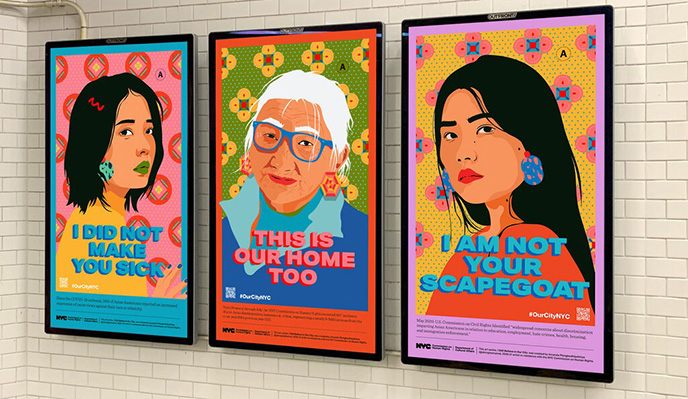CulBeat Express
2020.11.06 01:48
I Still Believe in Our City: 아만다 핑보디파키야(Amanda Phingbodhipakkiya)의 서브웨이 아트
조회 수 580 댓글 0
코로나 팬데믹으로 올 2월부터 뉴욕시 아시아계 타겟 범죄가 566건에 이르렀다.
아만다 핑보디파키야(Amanda Phingbodhipakkiya)가 아틀랜틱 애브뉴 터미널@바클리센터 지하철 플랫폼에 'I Still Believe in Our City'를 주제로 한 인물화를 전시하고 있다. 아만다 핑보디카피야는 1992년 아틀란타의 타이-인도네시아계 가정에서 태어나 컬럼비아대에서 신경과학을 전공한 후 컬럼비아메디컬센터에서 알츠하이머 연구원으로 일했다. 이후 프랫인스티튜트에서 커뮤니케이션을 전공해 화가로 진로를 바꾸었다.

Amanda Phingbodhipakkiya
"I Still Believe in Our City" Public Art Campaign
Asian and Pacific Islanders standing up for themselves, the Black Lives Matter movement, and their home: New York City I Still Believe in Our City
Message from the Artist
In 2020, as COVID-19 flared through New York City and NYC hospitals saw a spike of nearly 200,000 patients, Asian and Pacific Islanders (APIs) faced an added threat: blame, racism, and xenophobia.
From February through July, the NYC Commission on Human Rights recorded 184 incidents of anti-Asian discrimination, harassment, or bias, representing a nearly seven-fold increase from the same period the previous year (26). The majority of incidents reported nationwide have been against women,1 including an 89-year-old grandmother who was set on fire in Brooklyn.
Some might have thought we’d just slink off in the face of these assaults. But we don’t scare that easily. We mobilized, amplifying our voices to stand up for our communities. We got creative, finding novel ways to protect our parents, educate our children, and support our customers. APIs were on the frontlines, caring for patients, stocking shelves, and making deliveries around the clock. We’re made of grit, hustle and hope, the same as every New Yorker, and we know this city is greater than her ugliest moments.
Asian and Pacific Islanders are diverse in nationalities, religious traditions, cultural practices, and languages spoken. And whether we are new immigrants or generations-old New Yorkers, APIs share the common experience of being labeled the “perpetual foreigner.” Ask any API the last time they we were asked, “But where are you really from?” and they can recount the story. It’s a question that, intent aside, burns at the core of every Asian and Pacific Islander American’s sense of home.
This pain, made worse by the onset of COVID-19-related discrimination, carries with it the history of this country’s anti-Asian laws. From the Chinese Exclusion Act of 1882, to the immigration quotas barring immigration from Asian countries in the 1920s, APIs have been so othered that many cannot imagine Asian and Pacific Islanders as also being American. The Chinese Exclusion Act remains the only law in American history to make immigration by a specific nationality illegal.
By the 1960s, the civil rights movement was challenging every significant law and norm that denied Black people equal treatment. From restaurant counters to voting booths, civil rights leaders paved the way for equal rights for all. Asian and Pacific Islanders learned from this approach and mobilized under the banner of the civil rights movement to fight to abolish nation-based immigration quotas and secure passage of the Immigration and Naturalization Act of 1965. From Yuri Kochiyama to Grace Lee Boggs, API activists worked side-by-side with and were inspired by Black civil rights leaders —a connection that continues in today’s movement for Black lives, and a history that this public awareness initiative and art series seeks to honor.
More than an anti-hate campaign, this public awareness initiative is a testament to the beauty and resilience of API communities. It recognizes everything we’ve lived through this year but also speaks to decades-old anti-Asian biases. It’s a reminder that NYC needs us, and that we won’t give up on her.
In the wake of the pandemic, New Yorkers masked up and supported their essential workers. In the face of racial injustice and xenophobia, New Yorkers marched and stood in solidarity with their neighbors. “I Still Believe in Our City” affirms that Black lives matter, and that East and Southeast Asians refuse to be vilified or denigrated. No matter what comes our way. New Yorkers don’t succumb to cynicism or defeat. We choose to believe in and fight for ourselves, our home, and our shared future.

About the Art Initiative
“I Still Believe in Our City” was created by Amanda Phingbodhipakkiya, one of two 2020-21 artists-in-residence with the NYC Commission on Human Rights. The daughter of Thai and Indonesian immigrants, Phingbodhipakkiya’s practice centers around making the invisible, visible. Her multidisciplinary work has appeared in museums, galleries, conferences, classrooms, speakeasies, rallies, digital screens, and on buildings all over the world.
The works featured in “I Still Believe in Our City” couple striking visuals with statistics about discrimination API New Yorkers have faced amidst the COVID-19 pandemic. The panels include words and phrases that have been uttered in hate, juxtaposed with bright colors, symbolic imagery, and portraits of defiant and proud API New Yorkers standing their ground. Nestling the ugly language in beautiful symbolism is intentional: API artist Phingbodhipakkiya shows that despite what API New Yorkers have faced, they remain undeterred and steadfast members of New York City’s communities.
Atlantic South Liveboards MockupAtlantic South Mockup
It spans a range of activations, from LinkNYC kiosks, bus shelters, a public mural, and social media placements with the hashtag #OurCityNYC. An additional special feature of the campaign includes an art installation in the Atlantic Avenue terminal, where Phingbodhipakkiya’s 45 unique pieces take over the station to celebrate East Asian and Southeast Asian New Yorkers, as strong, compassionate members of their communities and show solidarity with the Black Lives Matter movement and the fight to eliminate anti-Black racism. The words and images on each activation may vary, but the message is the same: Asian and Pacific Islanders care about our city, they will not be vilified or victimized, and they are not going anywhere.
1 Stop AAPI Hate. (2020). Stop AAPI Hate Report March 19, 2020 – May 13, 2020.
https://www1.nyc.gov/site/cchr/media/pair-believe.page






